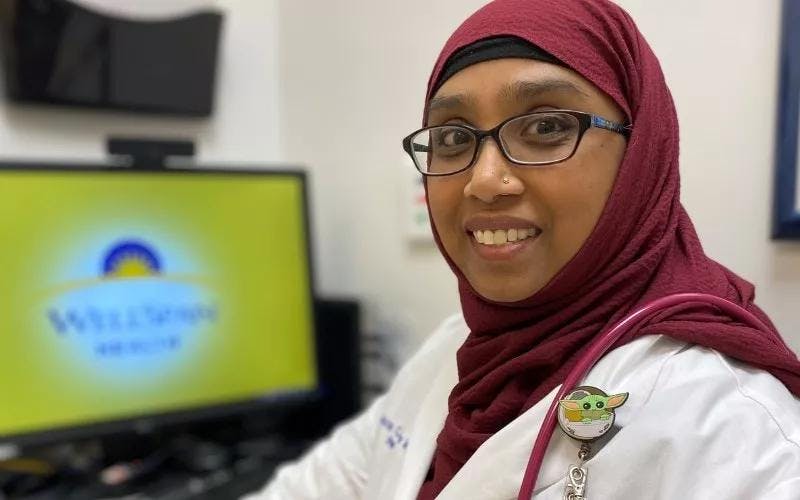When kids return to school, they sit in a group in class, eat lunch side by side, run around the gym together, pass papers, and share pens.
Let's face it. It's a germ paradise.
About a month after school starts, pediatricians see the predictable results: kids with colds, sore throats, and other viruses that bloom and grow due to all that togetherness. It's so common that some teachers and parents have nicknamed the phenomenon the "back-to-school plague."
"As medical providers, we also plan for back-to-school time " says Dr. Almira Contractor, WellSpan pediatrician. "New backpacks, new lunchboxes, and new germs – they all come into the house and then into our office in September. It can make for a challenging start to the school year for some families."
Colds, which are highly contagious, account for more visits to the doctor than any other condition, according to the American Lung Association. Young children suffer from an average of six to eight upper respiratory infections per year and, as parents know, often bring the cold germs home. Adults get an average of two to four colds a year, mostly during the school year, from September to May.
In addition to colds, the back-to-school plague can include ailments such as strep throat, stomach bugs, pink eye, and, eventually, influenza (particularly for those who are not vaccinated against it).
Here's how to prevent and treat these icky ailments, either on your own or with the help of a provider.
Prevention
One of the basic ways to stay healthy is as elementary as the ABCs.
Encourage your kids to wash their hands (singing the birthday song twice while lathering to ensure a thorough cleanse). Important handwashing times include before eating, after using the toilet, after blowing your nose, coughing, or sneezing, and upon arrival at home.
"Handwashing is one of the easiest ways to lessen the spread of germs," Dr. Contractor says. "Keep lunchboxes clean, pack wipes or sanitizer in lunchboxes as a reminder, and once home, have children remove shoes, wash up, and even change clothes."
In addition to handwashing, remember that other healthy habits include getting enough sleep at night and eating healthy foods.
Another important way to stay healthy and prevent certain illnesses is immunizations, which can protect kids from childhood diseases as well as the flu and COVID-19. Pennsylvania requires all school students be immunized against diseases such as tetanus, measles, polio, chickenpox, and, when they hit middle school, against a virus that can cause meningitis.
Starting in September, kids (as young as 6 months) also should be vaccinated against the flu.
Kids ages 6 months and older also should be vaccinated against COVID-19, as recommended by the U.S. Centers for Disease Control.
Schedule an appointment with your provider to make sure your child is up to date on the COVID-19 vaccine and other immunizations, so they can stay well during the school year. Remember that vaccinating your own children also helps ensure that those around them are protected, including babies, people with chronic diseases, and the elderly, who may not be protected.
When to call for help
Most common ailments resulting from the "back-to-school plague" can be treated with TLC. A common cold can be treated with rest, liquids, an over-the-counter nasal saline to irrigate the nasal passages and keep mucus moving, and honey for cough (however honey is only for children over the age of 1). A mild stomach virus also can be treated at home with rest, fluids, and mild foods.
There are a few signs that should trigger a prompt call to your pediatrician or primary care provider, or even a visit to your neighborhood WellSpan Urgent Care.
Be on the lookout for a high fever (102 degrees or higher for school-age children), neck pain, dizziness, shortness of breath, a persistent cough, and a noticeable drop in energy. See a medical provider if your child has stopped drinking or urinating or has been vomiting for several days. Also, crusty, bloodshot eyes are a sign of pink eye, which is very contagious and may require treatment with antibiotic drops.
"If you see these symptoms and think something is concerning, it's better not to wait," Dr. Contractor says. "Call your provider's office right away to speak with a nurse or make an appointment."
Keep your child home from school until he or she has been fever-free for 24 hours without medication or has gone 24 hours without vomiting or diarrhea.
"Do your part! Don't spread back-to-school infections to other families," Dr. Contractor says. "And make sure your own child is healthy and ready to learn when they go back to school."
Find a WellSpan primary care provider by going here. Find a WellSpan Urgent Care in your neighborhood by going here.
Tags:

